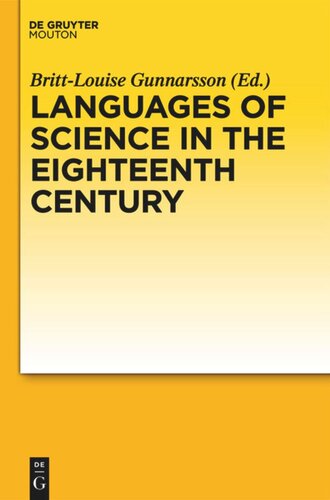

Most ebook files are in PDF format, so you can easily read them using various software such as Foxit Reader or directly on the Google Chrome browser.
Some ebook files are released by publishers in other formats such as .awz, .mobi, .epub, .fb2, etc. You may need to install specific software to read these formats on mobile/PC, such as Calibre.
Please read the tutorial at this link: https://ebookbell.com/faq
We offer FREE conversion to the popular formats you request; however, this may take some time. Therefore, right after payment, please email us, and we will try to provide the service as quickly as possible.
For some exceptional file formats or broken links (if any), please refrain from opening any disputes. Instead, email us first, and we will try to assist within a maximum of 6 hours.
EbookBell Team

4.1
60 reviewsThe eighteenth century is an important period both in the history of science and in the history of languages. Interest in science, and especially in the useful sciences, exploded and a new, modern approach to scientific discovery and the accumulation of knowledge emerged. It was during this century, too, that ideas on language and language practice began to change. Latin had been more or less the only written language used for scientific purposes, but gradually the vernaculars became established as fully acceptable alternatives for scientific writing. The period is of interest, moreover, from a genre-historical point of view. Encyclopedias, dictionaries and also correspondence played a key role in the spread of scientific ideas. At the time, writing on scientific matters was not as distinct from fiction, poetry or religious texts as it is today, a fact which also gave a creative liberty to individual writers.
In this volume, seventeen authors explore, from a variety of angles, the construction of a scientific language and discourse. The chapters are thematically organized into four sections, each contributing to our understanding of this dynamic period in the history of science: their themes are the forming of scientific communities, the emergence of new languages of science, the spread of scientific ideas, and the development of scientific writing. A particular focus is placed on the Swedish botanist Carl Linnaeus (1707-1778). From the point of view of the natural sciences, Linnaeus is renowned for his principles for defining genera and species of organisms and his creation of a uniform system for naming them. From the standpoint of this volume, however, he is also of interest as an example of a European scientist of the eighteenth century.
This volume is unique both in its broad linguistic approach - including studies on textlinguistics, stylistics, sociolinguistics, lexicon and nomenclature - and in its combination of language studies, philosophy of language, history and sociology of science. The book covers writing in different European languages: Swedish, German, French, English, Latin, Portuguese, and Russian. With its focus on the history of scientific language and discourse during a dynamic period in Europe, the book promises to contribute to new insights both for readers interested in language history and those with an interest in the history of ideas and thought.